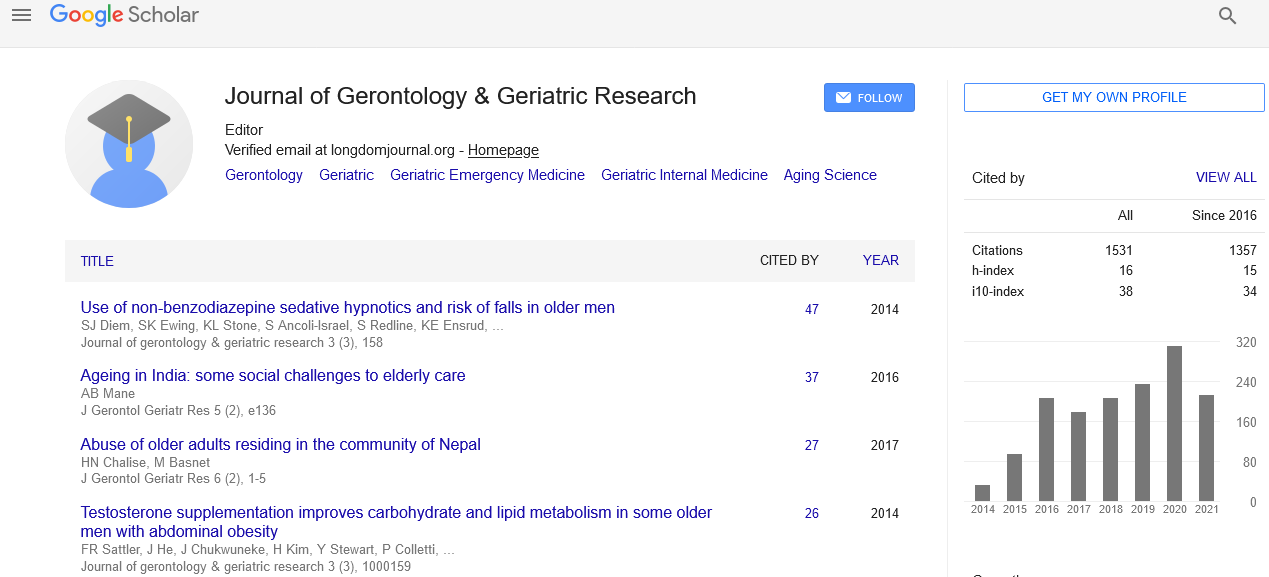PMC/PubMed Indexed Articles
Indexed In
- Open J Gate
- Genamics JournalSeek
- SafetyLit
- RefSeek
- Hamdard University
- EBSCO A-Z
- OCLC- WorldCat
- Publons
- Geneva Foundation for Medical Education and Research
- Euro Pub
- Google Scholar
Useful Links
Share This Page
Journal Flyer

Open Access Journals
- Agri and Aquaculture
- Biochemistry
- Bioinformatics & Systems Biology
- Business & Management
- Chemistry
- Clinical Sciences
- Engineering
- Food & Nutrition
- General Science
- Genetics & Molecular Biology
- Immunology & Microbiology
- Medical Sciences
- Neuroscience & Psychology
- Nursing & Health Care
- Pharmaceutical Sciences
Abstract
In the Emergency Department, Are Serum Biomarkers useful to Screen Independent Frail Seniors Exposed to Future Functional Decline or Mobility Impairments after a Minor Injury?
Mélissa Blouin, Marie-Josée Sirois, Mylène Aubertin-Leheudre, Lauren E Griffith, Linda Nadeau, Raoul Daoust, Jacques Lee and Marcel Émond
Background: Frailty is a geriatric syndrome conferring a high risk of declining functional capacities. Some serum biomarkers are associated with frailty, but no study has specifically investigated the possible association between frailty and serum biomarkers in independent community-dwelling seniors who consulted the emergency department (ED) following a minor injury.
Objective: 1) To explore baseline associations between six serum biomarkers and the frailty status of independent community-dwelling seniors who were seen in the ED for minor injuries, 2) to determine if ED serum biomarker assay combined with frailty status improves the prediction of 3-month functional decline or mobility impairments in this population, beyond frailty status alone.
Methods: The study includes 190 participants (age ≥ 65 years, independent in daily activities and discharged home). Biomarkers were obtained at baseline from blood samples and values were identified as “normal” or “at risk”. Seniors were classified as “robust” or “pre-frail/frail” according to the CHSA-CFS and SOF scales. The seniors were screened for frailty at baseline (ED visit) while their functional status (OARS scale) and mobility characteristics (less than 5 outings/week and fear of falling) were assessed at the ED visit and three months later.
Results: When compared to robust, a greater proportion of pre-frail/frail seniors had at-risk creatinine levels (p=0.02) at baseline. All the other biomarkers were not significant. In the prospective analysis, we found that having at least one at-risk biomarker slightly increased the prediction of 3-month mobility impairments in robust seniors (RR:0.44[0.10-1.91]). However, ED frailty status clearly remained the stronger predictor of future mobility impairments in pre-frail/frails having normal biomarkers (RR:3.11(0.98-9.84), p=0.007). Results were not significant for prospective functional decline.
Conclusion: ED biomarker assays are not useful in predicting 3-month functional decline or mobility impairments beyond what is predicted by frailty status alone in independent community-dwelling seniors who consulted for minor injuries.


